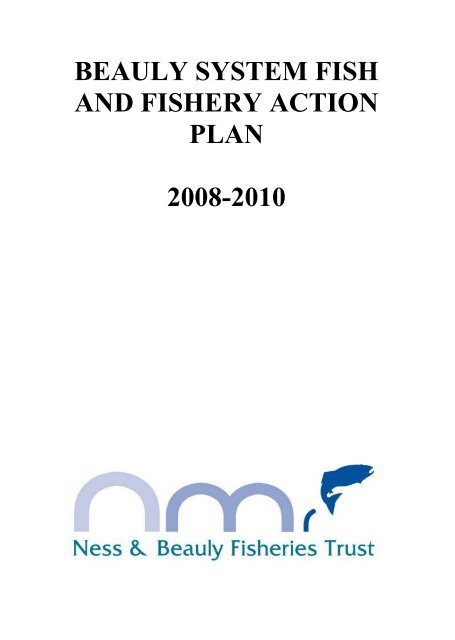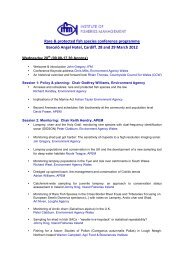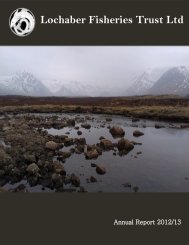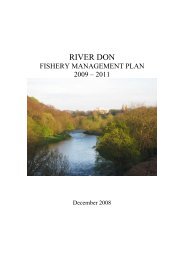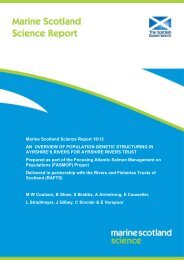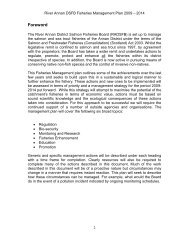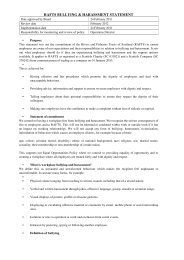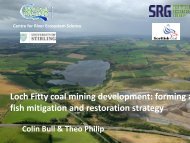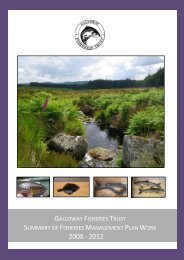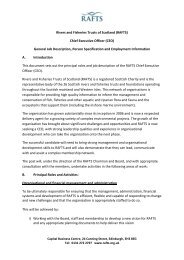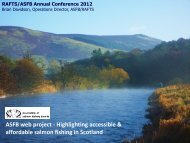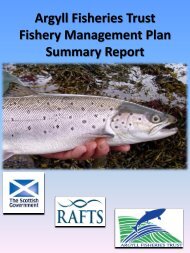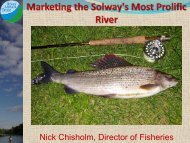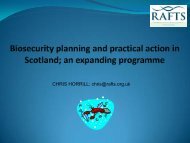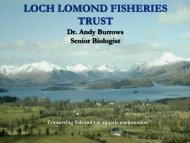BEAULY SYSTEM FISH AND FISHERY ACTION PLAN ... - RAFTS
BEAULY SYSTEM FISH AND FISHERY ACTION PLAN ... - RAFTS
BEAULY SYSTEM FISH AND FISHERY ACTION PLAN ... - RAFTS
Create successful ePaper yourself
Turn your PDF publications into a flip-book with our unique Google optimized e-Paper software.
<strong>BEAULY</strong> <strong>SYSTEM</strong> <strong>FISH</strong><strong>AND</strong> <strong>FISH</strong>ERY <strong>ACTION</strong><strong>PLAN</strong>2008-2010
IntroductionThe following plan has been drafted by the Ness & Beauly Fisheries Trust. During2007 and 2008, the Trust was contracted by the Scottish Government to produce anaudit of the available fish and fishery information on the Ness and Beauly catchments.All fisheries trusts in Scotland undertook a similar process. It is envisaged thatfisheries trusts throughout Scotland will utilise the information produced in the auditsin order to produce fisheries action plans for their area of remit. The plan has utilisedthe framework for the production of fish and fishery management plans published bythe Scottish Fishery Co-ordination Centre (SFCC) 1 . The plan has been drafted inconjunction with the Beauly District Fishery Board.It is envisaged that the framework provided by the plan will be flexible and willevolve during the timescale which the plan covers. The planning process is likely tobe iterative in nature with an assessment of the success and failures of the present planbeing incorporated into future planning cycles.Ness & Beauly Fisheries Trust Drafts Fishery Action PlanPlan Distributed to Fishery Board, Stakeholders etc ForCommentPlan ImplementedSuccess Reviewed Prior to Production of New Plan1 See www.sfcc.co.uk2
1. Aims and Objectives1.1 The aim of this plan is to provide a framework for the protection andenhancement of fish stocks native to the Beauly catchment and to ensure that anyexploitation of such stocks, by either commercial or recreational fisheries, isundertaken in a sustainable manner. Fish species that are not exploited byfisheries contribute to the biodiversity of the area and are often considered to beof high conservation value. As such, all fish species native to the Beaulycatchment have been included in the planning process. The remit of the Ness &Beauly Fisheries Trust includes all such species but it is noted that the remit ofthe Beauly District Fishery Board extends only to salmon and sea trout. The planalso recognises that management of fish stocks should be undertaken at apopulation rather than a species level when required.1.2 The plan covers the period 2008-2010. A relatively short planning period hasbeen chosen to ensure that a full evaluation of the success and failure of theimplementation of prescribed actions can be undertaken within a short timescale.It is expected that the Ness & Beauly Fisheries Trust will use the prescribedactions as a basis for its work programme during the planning period. It is likelythat new issues will arise during the planning period therefore the plan is flexiblein nature and is likely to be adapted during the planning period to meet therequirements of fish and fishery interests.1.3 It is recognised that cognisance of various other plans that are in existence, bothlocally and nationally, has to be taken into account in the production of fish andfishery action plans. The Ness & Beauly Fisheries Trust has contributed to thedrafting of the Inverness and Nairn Biodiversity Action Plan and the AreaAdvisory Group discussions re the Scottish River Basin Plan (a key component ofthe Water Framework Directive).1.4 Details of the area covered by the plan are illustrated in the maps on pages 4-6. Tofacilitate an assessment of the key pressures and actions required to mitigate forsuch pressures, the system has been sub-divided into smaller management units.Units comprise of: Lower Beauly (including Belladrum and Bruiach Burns);Upper Beauly; Farrar; and Glass, Cannich and Affric). This helps to define whichpressures and associated actions are generic across management units and whichare more geographically specific in nature. The choice of geographical extent ofeach management unit is somewhat arbitrary in nature and it is recognised that inthe future the increased use of genetic tools are likely to define more readily thegeographic range of populations of fish species. For the purposes of this plan theBeauly, Inverness and Moray Firths, including the many small burns that decantinto the Firths, constitute an additional management unit which is considered tobe part of the Beauly system. Lochs are included in the management unit of theclosest river.3
Beauly System Plan Area/0 25 50 100 KilometersBeauly CatchmentSome features of this map are based on digital spatial data licensed from theCentre for Ecology and Hydrology, © CEH. Includes material based on OrdnanceSurvey 1:50,000 maps with the permission of the controller of Her Majesty'sStationery Office © Crown copyright.4
<strong>BEAULY</strong> <strong>SYSTEM</strong><strong>BEAULY</strong>FARRARCANNICHGLASSAFFRIC/0 5 10 20 KilometersSome features of this map are based on digital spatial data licensed from theCentre for Ecology and Hydrology, © CEH. Includes material based on OrdnanceSurvey 1:50,000 maps with the permission of the controller of Her Majesty'sStationery Office © Crown copyright.5
<strong>BEAULY</strong> MANAGEMENT UNITS#*#* Aigas DamLower BeaulyFarrarUpper BeaulyGlass, Cannich and Affric/0 5 10 20 KilometersSome features of this map are based on digital spatial data licensed from theCentre for Ecology and Hydrology, © CEH. Includes material based on OrdnanceSurvey 1:50,000 maps with the permission of the controller of Her Majesty'sStationery Office © Crown copyright.6
2. Catchment and Fishery Description.2.1 Physical Characteristics of Catchment.The River Beauly drains a catchment of approximately 1000 square kilometres ofland thus making it the second largest catchment north of the Great Glen. Thecatchment extends almost to the west coast with the most westerly tributariesbeing only approximately 7km east of Loch Duich. The mean altitude of thecatchment is in excess of 385m and several peaks are in excess of 1000m.The Mullardoch and Affric regions of the upper catchment comprise largely ofmetamorphosed sedimentary rocks belonging to the Moine succession. AroundLoch Monar there are outcrops of older metamorphic rocks. Strathglass isdominated by quartz-feldspar-granulite. The Farrar catchment contains quartzfeldspar-granulite,schists and gneiss. The lower catchment is dominated by OldRed Sandstone.Maps illustrated below show the bedrock and superficial geologyof the Beauly catchment.The closest Met Office weather station to the region for which data is available isKinloss, although this is outside the Beauly catchment area. The 1971-2000average temperature at the weather station is 12.2 °C with annual averages of 53.5days of frost, 1261.4 hours of sunshine, 624.4mm rainfall and 127.6 days ofrainfall greater than 1mm. However, the Beauly catchment covers a large areaincluding sections in close proximity to the west coast. As such there is likely tobe a large geographic range in the temperature and rainfall patterns within thecatchment. This is reflected in the average rainfall values at the SEPA gaugingstations found in Table 1.Key to Superficial Geology:ALV = AlluviumBSA = Blown SandGSG = Glacial Sand and GravelPeat = PeatRMD = Raised Marine DepositsSlip = LandslipTill = TillUNKD = Unknown7
<strong>BEAULY</strong> BEDROCK GEOLOGYEpidiorite, hornblende-schist and allied typesGranite, syenite, granophyre and allied typesGranitic gneissLower Old Red Sandstone, including DowntonianMica-schist, semi-pelitic schist and mixed schistsMiddle Old Red SandstoneOpen WaterPorphyrite, lamprophyre and allied typesQuartz-feldspar-granuliteRhyolite, trachyte, felsite, elvans and allied typesUndifferentiated gneissBedrock data, Digital Geological Map of Great Britain 1:625 000 (DiGMapGB-625), BritishGeological Survey (2003), Ä and database right NERC.’8
<strong>BEAULY</strong> SUPERFICIAL GEOLOGYALVGSGPEATRMDSLIPTILLUNKNDSuperficial Deposits data, Digital Geological Map of Great Britain 1:625,000 (DiGMapGB-625),British Geological Survey (2003), © and database right NERC.9
Table 1 represents a summary of data available from the National River FlowArchive.Table 1StationAverage Flow Q95 (m 3 .s -1 ) Average Rainfall (mm)(m 3 .s -1 )Kerrow Wood (River Glass) 31.73 9.994 2294Erchless (River Beauly)* 45.63 14.16 2153Struy (River Farrar)* 19.26 6.171 1148Fasnakyle (River Glass)* 4.52 1.13 2209* Denotes historical archive data only as recording station no longer in operation.2.2. Land Use.Land use within the Beauly is broadly similar to neighbouring catchments withlarge areas owned by sporting estates and forestry enterprises (often utilised fordeer stalking), rough grazing for cattle and sheep and both commercial timberforestry and native woodland. The largest urban conurbation is Beauly, located inthe lower reaches of the River Beauly system. Glen Affric contains the thirdlargest remnant of the Caledonian Forest and has been designated as a NationalNature Reserve.10
<strong>BEAULY</strong> L<strong>AND</strong> USEArableBrackenBroadleavesConifersFelled woodlandFreshwatersGood rough grasslandHeather moorImproved grasslandMissing/obscured dataMixed woodlandOther mosaicsPeatlandPoor rough grasslandRecent plantingScrubTidal watersUrbanLand Cover of Scotland data, 1:25,000, MLURI 199311
Table 2Management Unit Salmon Trout Char Eel Lamprey Flounder Stickleback Grayling Rainbow Minnow Pike PerchTroutLower Beauly ● ● ● ● ● ●*Upper Beauly ● ● ● ● ● ●Farrar ● ● ● ● ● ●?**Glass, Cannich & Affric ● ● ● ● ● ● ●Beauly and InvernessFirths● ●* A single grayling specimen was recorded by the Galloway Fisheries Trust in the Bruiach Burn in 2002.** Angling literature has cited Loch Monar as having perch present but this has not been confirmed.13
Table 3Loch Brown Charr Salmon Lamprey Eels Minnows Perch Rainbow PikeTroutTroutNa Beinne ●MorNa Freumh ●Gaoireach ●Na Greidil ●Na Beinne ●●BigeNa Luch ●Nam Fiodhag ●Na Craobhe ●Monar ● ● ●Mullardoch ●Affric●Beinn●A’MheadhoinBruicheach ● ●Beannacharan ● ●Electro-fishing data held by the Ness & Beauly Fisheries Trust has been used togenerate distribution maps for individual species within the catchment (pages 15-20). It should be noted, however, that many of the smaller tributaries in thecatchment appear never to have been surveyed. Additionally, as previously noted,surveys in lacustrine habitat have been extremely limited in extent and thereforeno data relating to lochs has been included in the maps for the purposes of thisreport.Electro-fishing data on the Beauly system has been collected annually since 2000.However, not all sites have been visited each year, sites selected have includedstocked areas and there have been differences in methodology adopted bysurveyors. As such, it is difficult to reach any meaningful conclusions with regardto changes in density, growth etc from available data.14
<strong>BEAULY</strong> SALMON DISTRIBUTION!( !(!( !(!(!(!(!( !(!(!(!(!( !( !( !(!(!(!(!(!(!(!(!(!( !(!(!(!(!(!(!(!(!(!( !( !(Salmon!(05 10 20 KilometersSome features of this map are based on digital spatial data licensed from theCentre for Ecology and Hydrology, © CEH. Includes material based on OrdnanceSurvey 1:50,000 maps with the permission of the controller of Her Majesty'sStationery Office © Crown copyright.15
<strong>BEAULY</strong> TROUT DISTRIBUTION!( !(!( !(!(!(!(!( !(!(!(!(!( !( !( !(!(!(!(!(!(!(!(!(!(!( !(!(!(!(!(!(!( !(!(!( !( !(Trout!(05 10 20 KilometersSome features of this map are based on digital spatial data licensed from theCentre for Ecology and Hydrology, © CEH. Includes material based on OrdnanceSurvey 1:50,000 maps with the permission of the controller of Her Majesty'sStationery Office © Crown copyright.16
<strong>BEAULY</strong> MINNOW DISTRIBUTION!(!(!(!(!(!(!(!(!(!(!(Minnow!(05 10 20 KilometersSome features of this map are based on digital spatial data licensed from theCentre for Ecology and Hydrology, © CEH. Includes material based on OrdnanceSurvey 1:50,000 maps with the permission of the controller of Her Majesty'sStationery Office © Crown copyright.17
<strong>BEAULY</strong> EEL DISTRIBUTION!(!( !(!(!(!(!(!(!(!( !(!(!(!(!(!(!(Eel!(05 10 20 KilometersSome features of this map are based on digital spatial data licensed from theCentre for Ecology and Hydrology, © CEH. Includes material based on OrdnanceSurvey 1:50,000 maps with the permission of the controller of Her Majesty'sStationery Office © Crown copyright.18
<strong>BEAULY</strong> LAMPREY DISTRIBUTION!(!(!( !(!(!(!(Lamprey!(05 10 20 KilometersSome features of this map are based on digital spatial data licensed from theCentre for Ecology and Hydrology, © CEH. Includes material based on OrdnanceSurvey 1:50,000 maps with the permission of the controller of Her Majesty'sStationery Office © Crown copyright.19
<strong>BEAULY</strong> STICKLEBACK DISTRIBUTION!(Stickleback!(05 10 20 KilometersSome features of this map are based on digital spatial data licensed from theCentre for Ecology and Hydrology, © CEH. Includes material based on OrdnanceSurvey 1:50,000 maps with the permission of the controller of Her Majesty'sStationery Office © Crown copyright.20
Stock StatusFish counter data for salmon is available from three locations within the Beaulycatchment, namely Kilmorack, Aigas and Beannacharan. Fish counters aremaintained by Scottish & Southern Energy. Salmon count details can be found inTable 4, 5 and 6. Overall, the five year average of counts at Aigas Dam hasdeclined from approximately 8,000 in 1970 to around 4,000 at present.Aigas (River Beauly)140001200010000Count80006000Count400020000196319661969197219751978198119841987199019931996199920022005YearKilmorack (River Beauly)60005000Count400030002000Count100001997 1998 1999 2000 2001 2002 2003 2004 2005 2006 2007Year21
Beannacharan (River Farrar)800700600Count500400300Count2001000196319661969197219751978198119841987199019931996199920022005YearHabitat AssessmentA survey of habitat quality in respect of juvenile salmonids commenced in 2007.The survey is ongoing but it is expected that the survey of areas accessible tomigratory salmonids will be completed within the current planning cycle. Oncesurveys are completed, it is expected that habitat quality, obstacles to migrationetc will be mapped in preparation for potential remedial action. It is furtherexpected that the habitat data will be used to produce conservation limits andidentifying suitable areas for stocking etc. Areas in which habitat surveys havebeen completed are illustrated in the following map.22
<strong>BEAULY</strong> HABITAT SURVEY!(!(!(!(!(!(!( !(!(!(!(!(!(!(!(!(!(!(!(!(!(!(!(!(!(!(!(!( !(!(!(!( !(!(!(!( !(!(!(!( !(!(!(!(!(!(!(!(!(!(!(!(!(!(!(!(!( !(!(!(!(!(!(!(!(!(!(!(!(!(!(!(!(!(!(!(!(!(!(!(!(!(!(!(!(!(!(!(!(!(!(!(!(!(!(!(!(!(!(!(!(!(!(!( !(!(!(!(!(!(!(!(!(!(!(!(!(!(!(!(!(!(!(!(!(!(!(!(!(!(!(!(!(!(!(!(!(!(!(!(!(!(.05 10 20 Kilometers!( Upstream Extent Of Survey TransectSome features of this map are based on digital spatial data licensed from theCentre for Ecology and Hydrology, © CEH. Includes material based on OrdnanceSurvey 1:50,000 maps with the permission of the controller of Her Majesty'sStationery Office © Crown copyright.23
2.4 FisheriesRod catch data from the River Beauly system suggests that the spring salmoncomponent of the stock has declined in recent decades compared to the 1950’s and60’s. Summer catches are now dominated by grilse, and the number of summersalmon captured has also declined from the late 1980’s onwards. Rod catches ofsea trout have displayed a seemingly remorseless decline from an annual rod catchof approximately 2,500 in the 1950’s to less than 250 at the present time. Thefollowing graph illustrates the trend in catches of spring salmon, summer salmonand grilse. It should be noted that spring salmon are deemed to be those capturedprior to the month of May.Beauly Rod and Line Salmon Catch25002000C a t c h15001000SpringSummerGrilseTotal50001 9 5 21 9 5 41 9 5 61 9 5 81 9 6 01 9 6 21 9 6 41 9 6 61 9 6 81 9 7 01 9 7 21 9 7 41 9 7 61 9 7 81 9 8 0Year1 9 8 21 9 8 41 9 8 61 9 8 81 9 9 01 9 9 21 9 9 41 9 9 61 9 9 82 0 0 02 0 0 22 0 0 42 0 0 624
Beauly Rod and Line Sea Trout Catch350030002500C a t c h20001500SeaTrout100050001 9 5 21 9 5 41 9 5 61 9 5 81 9 6 01 9 6 21 9 6 41 9 6 61 9 6 81 9 7 01 9 7 21 9 7 41 9 7 61 9 7 8Year1 9 8 01 9 8 21 9 8 41 9 8 61 9 8 81 9 9 01 9 9 21 9 9 41 9 9 61 9 9 82 0 0 02 0 0 22 0 0 42 0 0 6No net fisheries have operated within the Beauly catchment since 1986.Information available to the Ness & Beauly Fisheries Trust for catches of speciesother than salmon and migratory trout is extremely limited. It is recognised thatthe lack of data on catches and general status of such species represents a majorgap in knowledge and badly hinders fishery management.2.5 Hatchery UseA hatchery situated near the village of Beauly is operated by the Lower BeaulyFishings Syndicate. The capacity of the hatchery is approximately 250,000. Mostjuvenile salmon are stocked out to fry stage although some are also reared to parrstage.2.6 Predators and Competing SpeciesEach fish species within the Beauly catchment is subject to predation by a suite ofpiscine, avian and mammalian predators. These are both native (e.g. otters) andnon-native (e.g. pike and mink) to the catchment. In addition, introduced speciessuch as minnows may compete with native fish for resources e.g. food. Somepredatory species are controlled by plans such as the Moray Firth SealManagement Plan whilst others are not controlled in any systematic way.25
3. Factors Limiting Fish ProductionFish production within both the Beauly system is a function of natural factors suchas the availability of spawning and juvenile habitats and anthropogenicallyinduced factors such as the loss of smolts due to damage by hydro-electricturbines. For the purposes of this report, emphasis will be placed on anthropogenicfactors or factors in which anthropogenic intervention is likely to haveexacerbated natural constraints. The system has been subjected to considerableanthropogenic alteration, which is likely to have considerably lowered itsproductive potential. It is recognised, however, that many of the fish speciespresent are highly migratory in nature (e.g. salmon, trout and eels) and thereforefactors affecting the marine environment, both natural and anthropogenic, are alsoan important consideration in determining overall productivity.For the purposes of this report the following are considered to be the mostimportant potential limiting factors. Many of these factors have been identified bySEPA and have been discussed via the Area Advisory Group.I. Impoundment and Water Abstraction.The Beauly system has been subjected to extensive hydro-electric schemes. Thisis likely to have impacted upon its productive potential in a number of waysincluding lack of access for migratory fish to historical spawning areas due to lackof fish passes in some dams, provision of inefficient fish passes, alterations tohydrological regimes, changes in water chemistry and nutrient status, lack ofsediment transfer, the creation of ‘pinch points’ for the predation of bothmigrating juveniles and adults and the transfer of water between rivers which mayalter migration patterns. Other significant sources of impoundment and abstractionare also present on the Beauly system (e.g. by Scottish Water).II. PredationFish species are removed from the Beauly system by a suite of predators –including species introduced to the area (e.g. pike). For migratory speciespredation occurs in both freshwater and marine environments. Predation pressuresmay well be exacerbated by the presence of structures such as dams etc whichcreate ‘pinch points’. Of particular concern is predation on migratory fish duringstages of their life cycle after which density dependent compensation for losses islikely to be exhausted e.g. salmon and sea trout smolts and returning adults.III. Non-native species.The Beauly system contains a variety of species that are not native to theHighlands of Scotland. This may increase levels of predation (e.g. mink and pike)or increase competition for food and habitat (e.g. minnows).26
IV. Barriers to Migration.Poorly designed road culverts, bridge aprons etc have reduced the availablehabitat for many fish species, particularly those adopting an anadromous lifehistory. Some obstructions / potential obstructions have already been identified inhabitat surveys. Log jams can cause similar problems and can be regarded asepisodic in nature. Habitat surveys will continue in order to identify log jams,culverts etc.V. Cultural Oligotrophication.Evidence from sediment cores in Loch Ness suggests that the nutrient status of thehigher reaches of the Ness catchment has altered considerably since the last iceage due to both natural and anthropogenic factors. It is likely that the naturalproductivity of many upland areas in the Beauly catchment has been lowered as aresult of a similar process.VI. Exploitation by Fisheries.Despite the adoption of catch and release within the Beauly catchment it is likelythat some salmon and sea trout populations which are currently numericallydepressed are over-exploited by fisheries leading to a reduction in the number ofadults available for spawning.VII. Forestry.Large areas of the Beauly catchment contain commercial forestry plantations.Forestry practices may have both positive and negative impacts on fishproduction. Negative impacts are likely to include silt inputs, acidification andover-shading of watercourses. Positive impacts include the provision of shade.Habitat surveys are currently being undertaken to assess the extent of forestry thatdoes not conform to the published Forest and Water Guidelines.VIII. Climate Change.An emerging and episodic influence on fish production is the apparent increase insevere weather conditions, particularly flood episodes. There is an increasedprobability of redd washout etc as a result of this factor. Linked to this areincreased proposals for hard engineering, gravel removal etc in respect of flooddefence schemes all of which have the potential for damaging fish stocks.IX. Pollution.Diffuse and point-source pollution occurs in various locations within thecatchment although overall water quality appears to be good. A particular concernhas been perceived high levels of pollution in the Moray Firth.27
X. Agriculture.Poor agriculture practices are likely to have lowered the quality of habitat in manylowland areas via pollution, increased sediment inputs and inappropriate physicalalterations to watercourses.X1. Illegal Fishing.Illegal fishing has the potential to reduce the amount of fish available forlegitimate fishing and may also reduce the number of adult fish available forspawning. Water bailiffs patrol the Beauly catchment.Table 7 represents an assessment by the Ness & Beauly Fisheries Trust withregard to the magnitude of impact the above factors have, or are likely to have inthe future, on fishery production within the respective management units.Table 4I II III IV V VI VII VIII IX X XILower Beauly H H M H M M M M L M MUpper Beauly H H H M M M M M L M MFarrar H H H M M M M MGlass,Cannich & Affric H H H L M M M M M M MBeauly, Inverness & MorayFirthsM H M M H H MH = High SignificanceM = Moderate SignificanceL= Low SignificanceBlank = No Significance28
4 Actions.Lower Beauly (including Belladrum and Bruiach).Impact Action Partners Expectation 2008 2009 2010Monitor charr population of LochY YBruicheach.Impoundmentand Abstraction.? Assess if increasedabstraction damages charrpopulation prior to CARlicence renewal.Predation.Obtain licence to lower predation viaMoray Firth Seal Management Groupand Moray Firth Sawbill ManagementGroup.Moray Firth SealManagement Group. MorayFirth Sawbill ManagementGroup.Lower Predation pressureparticularly on migratoryspecies.Y Y YBarriers toMigration.Continue annual surveys to ensure logjams in Belladrum and Bruiach riversdo not prevent migration.Maintain access to spawningareas.Y Y Y29
Lower Beauly (Continued).OtherManagementActivities.Timed electro-fishing surveys.Obtain index of abundance offish species and theirdistribution. Identify sites forlong-term monitoring.YYYDetailed electro-fishing surveys for long-termmonitoring.Detect changes in juvenileabundance.YYYCollection of genetic material for future analyses.Processing of samples.SALSEA, FRS, AST.Provide information onpopulation structure andexploitation of stocks.YYYLiaise with estates etc to obtain any available recordson trout, charr catches etc. Consider use of log bookschemes.Local estates.Improve data for non-migratoryand non-salmonid fish.YYYContinue water bailiff patrols etc.Reduce illegal fishing.YYYContinue to engage with Forestry CommissionRecreation Rangers, Highland Council Rangers andothers to develop and deliver environmentaleducation initiatives.ForestryCommission,Highland Council.Improve understanding of theaquatic environment.YYYContinue to develop relationships with SEPA, SNH,Highland Council, Forestry Commission etc to ensurethat the aquatic environment is fully taken intoconsideration in ongoing planning processes.SEPA, SNH, ForestryCommission,Highland Council.Safeguard and improve aquaticenvironment.YYY30
Upper Beauly.Impact Action Partners Expectation 2008 2009 2010Ascertain if sediment reintroduction is Scottish and Southern Energy.Y Y Ypossible below dams.SEPA.Impoundment andAbstraction.Improve habitatespecially spawningareas.Predation.Non-nativespecies.Obtain licence to lower predation viaMoray Firth Seal Management Group andMoray Firth Sawbill Management Group.Cull Mink.No management options currentlyavailable in terms of pike and minnowremoval.Moray Firth Seal ManagementGroup. Moray Firth SawbillManagement Group.Lower Predationpressure particularly onmigratory species.Y Y YSNH. Reduce predation. Y Y Y31
Upper Beauly (continued).OtherTimed electro-fishing surveys.ManagementActivities.Obtain index of abundance of fish species andtheir distribution. Identify sites for long-termmonitoring.YYYDetailed electro-fishing surveys forlong-term-monitoring.Detect changes in juvenile abundance.YYCollection of genetic material for futureanalyses. Processing of samples.SALSEA, FRS,AST.Provide information on population structure andexploitation of stocks.YYYInvestigate potential use of PIT tagtechnology at Scottish & SouthernDams and potential sites for rotaryscrew traps.Scottish &SouthernEnergy.Assess survival rates of salmon smolts betweendams. Increase accuracy of conservation limitsproduced by fisheries trust.YYYComplete Habitat Survey.Lower BeaulyFishingsSyndicate.Improve accuracy of conservation limits producedby fisheries trust. Identify areas for habitatimprovement. Assess suitability of areas forstocking.YYLiaise with estates etc to obtain anyavailable records on trout, charr catchesetc. Consider use of log book schemes.Local estates.Improve data for non-migratory and non-salmonidfish.YYYValidate fish counts at dams using mk11fish counters and associated software.Scottish &SouthernEnergy.Increase accuracy of conservation limits. Ensurecounts are accurate.YY32
Upper Beauly (continued).Other Management Continue water bailiff patrols.Activities(continued). Continue to engage with ForestryCommission Recreation Rangers,Highland Council Rangers and othersto develop and deliver environmentaleducation initiatives.ForestryCommission,HighlandCouncil.Reduce illegal fishing.Improve understanding of the aquaticenvironment.YYYYYYContinue to develop relationships withSEPA, SNH, Highland Council,Forestry Commission etc to ensurethat the aquatic environment is fullytaken into consideration in ongoingplanning processes.SEPA, SNH,ForestryCommission,HighlandCouncil.Safeguard and improve aquatic environment.YYY33
Glass, Cannich and Affric.Impact Action Partners Expectation 2008 2009 2010Ascertain if sediment reintroduction is Scottish and Southern Energy.Y Y Ypossible below dams.SEPA.Impoundment andAbstraction.Improve habitatespecially spawningareas.Predation.Non-nativespeciesObtain licence to lower predation viaMoray Firth Seal Management Group andMoray Firth Sawbill Management Group.Cull Mink.No management options currentlyavailable in terms of pike and minnowremoval.Moray Firth Seal ManagementGroup. Moray Firth SawbillManagement Group.Lower Predationpressure particularly onmigratory species.Y Y YSNH. Reduce predation. Y Y Y34
Glass, Cannich and Affric (continued).OtherManagementActivitiesTimed electro-fishing surveys.Obtain index of abundance of fish species andtheir distribution. Identify sites for long-termmonitoring.YYYDetailed electro-fishing surveys forlong-term-monitoring.Detect changes in juvenile abundance.YYCollection of genetic material for futureanalyses. Processing of samples.SALSEA, FRS,AST.Provide information on population structure andexploitation of stocks.YYYInvestigate potential use of PIT tagtechnology at Scottish & Southern Damsand potential sites for rotary screw traps.Scottish &SouthernEnergy.Assess survival rates of salmon smolts betweendams. Increase accuracy of conservation limitsproduced by fisheries trust.YYYComplete Habitat Survey.Lower BeaulyFishingsSyndicate.Improve accuracy of conservation limits producedby fisheries trust. Identify areas for habitatimprovement. Assess suitability of areas forstocking.YYLiaise with estates etc to obtain anyavailable records on trout, charr catchesetc. Consider use of log book schemes.Local estates.Improve data for non-migratory and non-salmonidfish.YYY35
Glass, Cannich and Affric (continued).Other Management Validate fish counts at dams using mk11 fish countersActivitiesand associated software.(continued).Scottish & SouthernEnergy.Increase accuracy ofconservation limits.Ensure counts areaccurate.YYYContinue water bailiff patrols.Reduce illegal fishing.YYYContinue to engage with Forestry CommissionRecreation Rangers, Highland Council Rangers andothers to develop and deliver environmental educationinitiatives.Forestry Commission,Highland Council.Improve understanding ofthe aquatic environment.YYYContinue to develop relationships with SEPA, SNH,Highland Council, Forestry Commission etc to ensurethat the aquatic environment is fully taken intoconsideration in ongoing planning processes.SEPA, SNH, ForestryCommission,Highland Council.Safeguard and improveaquatic environment.YYY36
Farrar.Impact Action Partners Expectation 2008 2009 2010Impoundmentand Abstraction.Assess options for providingcompensation flows for dewateredburns.SEPA, Scottish &Southern Energy andriparian owners.Increase availability of fishhabitat.Y Y YPredation.Non-nativespecies.Obtain licence to lower predation viaMoray Firth Seal ManagementGroup and Moray Firth SawbillManagement Group.Cull Mink.Moray Firth SealManagement Group.Moray Firth SawbillManagement Group.SNH.Lower Predation pressureparticularly on migratory species.Reduce predation.Y Y YY Y YAssess predation by pike in LochBeannacharan.Scottish & SouthernEnergy and riparianowners.Inform financial assessment offeasibility of construction of trapand transportation of salmonsmolts around lochs.YY37
Farrar (continued).OtherManagementActivitiesTimed electro-fishing surveys.Obtain index of abundance of fish species andtheir distribution. Identify sites for long-termmonitoring.YYYDetailed electro-fishing surveys forlong-term-monitoring.Detect changes in juvenile abundance.YYCollection of genetic material for futureanalyses. Processing of samples.SALSEA, FRS,AST.Provide information on population structure andexploitation of stocks.YYYInvestigate potential use of PIT tagtechnology at Scottish & Southern Damsand potential sites for rotary screw traps.Scottish &SouthernEnergy.Assess survival rates of salmon smolts betweendams. Increase accuracy of conservation limitsproduced by fisheries trust.YYYObtain and process invertebrate samplesfrom East Deanie Burn.Obtain indication of possible acid episodes.YComplete Habitat Survey.Lower BeaulyFishingsSyndicate.Improve accuracy of conservation limits producedby fisheries trust. Identify areas for habitatimprovement. Assess suitability of areas forstocking.YYLiaise with estates etc to obtain anyavailable records on trout, charr catchesetc. Consider use of log book schemes.Local estates.Improve data for non-migratory and non-salmonidfish.YYY38
Farrar (continued).Other ManagementActivities(continued).Validate fish counts at dams using mk11 fish countersand associated software.Scottish & SouthernEnergy.Increase accuracy ofconservation limits. Ensurecounts are accurate.YYYContinue water bailiff patrols.Continue to engage with Forestry CommissionRecreation Rangers, Highland Council Rangers andothers to develop and deliver environmental educationinitiatives.Forestry Commission,Highland Council.Reduce illegal fishing.Improve understanding ofthe aquatic environment.YYYYYYContinue to develop relationships with SEPA, SNH,Highland Council, Forestry Commission etc to ensurethat the aquatic environment is fully taken intoconsideration in ongoing planning processes.SEPA, SNH, ForestryCommission,Highland Council.Safeguard and improveaquatic environment.YYYAssess feasibility of radio-tracking programme toascertain origin of early-running salmon on Beaulysystem and enact programme if deemed appropriate.Highlight areas ofcatchment that requireadditional managementmeasures.YYY39
Beauly, Inverness and Moray Firths.Impact Action Partners Expectation 2008 2009 2010Barriers. Habitat and electro-fishing surveys to identify Moray Firth Sea Identify barriers that requireY Ybarriers to migration, fish distribution etc. Trout Project.remedial action.Pollution.Agriculture.Continue to lobby SEPA for increased testing inAlturlie area.Habitat surveys to identify areas suffering fromexcessive silt inputs, canalisation etc.SEPA.SEPA.Moray Firth SeaTrout Project.Identify cause of perceivedpollution problem at Alturlie.Identify areas for possible habitatimprovement.Y Y YYY40
Beauly, Inverness & Moray Firths (continued).AdditionalContinue water bailiff patrols.ManagementActivities. Collection of genetic material for future analyses.Processing of samples.Moray Firth Sea TroutProject. SALSEA,FRS, AST.Reduce illegal fishing.Improve knowledge offish distribution andpopulation structure.YYYYYEvaluate potential of sampling of fish in Firth usingnetting etc.Moray Firth Sea TroutProject.Establish growth rates ofsea trout etc.YYContinue to engage with Forestry Commission RecreationRangers, Highland Council Rangers and others to developand deliver environmental education initiatives.Forestry Commission,Highland Council.Improve understanding ofthe aquatic environment.YYYContinue to develop relationships with SEPA, SNH,Highland Council, Forestry Commission etc to ensure thatthe aquatic environment is fully taken into considerationin ongoing planning processes.SEPA, SNH, ForestryCommission, HighlandCouncil.Safeguard and improveaquatic environment.YYY41
5. Monitoring and ReviewThe objectives of this plan and action points will be reviewed annually. Inaddition, a thorough appraisal of the success and failures of the plan will beundertaken prior to the drafting of a new plan for the next planning cycle.6. DataData held by the Ness & Beauly Fisheries Trust is itemised in Fisheries ResearchServices Contract Report 2007-2008 copies of which are available from the Trustby request.42
Appendix IAcronymsAST – Atlantic Salmon Trust.FRS – Fisheries Research Services.SALSEA – Salmon at Sea.SEPA – Scottish Environment Agency.SNH – Scottish Natural Heritage.Contact AddressNess & Beauly Fisheries TrustCorff HouseBeaulyIV4 7BE43
Appendix IIDraft copies of this action plan were sent to the following organisations for comment:Beauly District Fishery BoardScottish & Southern EnergyScottish Natural HeritageScottish Environment Protection AgencyBeauly Angling ClubRivers and Fisheries Trusts ScotlandForestry Commission (Scotland)Details of the responses received are reproduced below. Additionally, a genericresponse to fishery management plans obtained from Scottish Water by Rivers andFishery Trusts Scotland is also reproduced. It should be noted that a number ofchanges to the draft plan originally circulated have been have been made in responseto the comments received. It is also likely that other suggested improvements will beincorporated into future iterations of action plans for the Ness system.SEPA’s response to the Ness & Beauly Fishery Management PlanSEPA support the work outlined in the Ness and Beauly Fishery Management Plan(FMP) on data collection and habitat improvement. These activities will make animportant contribution to improving our knowledge base and enhancing theecological status of the local water environment.Species and habitat managementThe section on obstructions to fish movement is an issue of particular interest to SEPA. Wehave been developing with <strong>RAFTS</strong> a system for describing the extent to which barriersimpede migration and would be very keen to see this methodology applied as part of the auditof barriers. SEPA is currently updating the fish barriers information which has been used forthe classification of rivers. We are hoping to update our list by January 21 st and we will usethe information provided in this FMP as well as contacting you to ensure we have the mostaccurate listing possible.The summary of monitoring effort since 2000 given in the Beauly plan acknowledgesthat ‘it is difficult to reach meaningful conclusions with regard to changes in density,growth etc from available data’. This seems to suggest that there may be scope forexploring ways to improve on the monitoring effort, and consideration of this wouldbe a welcome addition to the plan.The fish distribution maps in the plans are of interest, although the small symbolsindicating presence are rather difficult to see in standard screen display. Onelimitation of such maps is that the absence of a species from a watercourse mayeither reflect the true situation or be because no survey has been done there. Morerigorous recording of all species during survey, together with a display of absence aswell as presence, would be the ideal.44
There is reference to the presence of ‘lamprey’ in the river systems, but nodifferentiation between sea lamprey and the two Lampetra species. It would behelpful to distinguish them where possible.The tabulated fish counter data is of interest, but perhaps would be better presentedas graphs. It is unclear if the Scottish Fisheries Coordination Centre has beeninvolved in training survey staff or for data storage and collation. Compliance withSFCC protocols and the use of their facilities for data handling is to be recommendedand might add value to the current surveys and monitoring efforts.There is recognition of gaps in fish stock data, particularly for lochs and for nonsalmonidspecies. SEPA welcomes the plans’ aim to try and fill such gaps –something that is widely acknowledged as a shortcoming nationally.The Ness plan refers to changing forestry practice and the increased planting ofnative broad-leaved trees. SEPA also favours this policy, which may be relevant tothe cultural oligotrophication referred to elsewhere in the plan, as well as to otherbiodiversity gains.Links to Water Framework Directive and River Basin Management PlanningAt present the plan contains some references to the Water Framework Directive (WFD) andthe North Highland Area Advisory Group. SEPA is keen to work with stakeholders and thiswill underpin much of its work as it implements the WFD and operates under the WaterEnvironment and Water Services (Scotland) Act 2003. We think it would be helpful to have aspecific reference to the draft North Highland Area Management Plan in the fisherymanagement plan, so that readers can easily see the links and synergies between the twoplans.We would also like to suggest that the fisheries management plan could referencethe WFD classification results for the area. We appreciate that the classification datahas only very recently become available, but it would provide the most up to datepicture of the current status of the catchments in WFD terms. It would also enable theactions of the plan to be put into context in terms of their potential contribution toimproving water bodies to good status or preventing deterioration. The classificationresults will be updated each year based on new monitoring data and developments inthe classification process. We may be able to provide you with maps showingpollution, hydrology and morphology impacts.We note your Fisheries Management Plan includes a range of opportunities to workwith, and communicate to others who manage, impact and use the waterenvironment. We welcome this activity as it will hopefully result in behaviouralchanges which will benefit the water environment.RegulationSome of the activities to deliver your projects outlined in the Action Plan could potentiallycome under the Controlled Activities Regulations (CAR). Your local SEPA team in Dingwallwill be able to advise you on any of these authorisation requirements.45
Dear KeithThanks for the disc ,I have just read the action plans for the Ness and Beauly Action plans. They are both reallygood and interesting. My only comments would be that the Paragraphs concerning forestryare the same for both plans and both don’t identify action points specifically. They have toidentify things you want to achieve by the end of the plan.The action points could includeCloser working with Forest Districts Planning teams to have a long term influence in ForestDesign plansBuilding productive working relationships with District staff in Operations, Planning ,ConservationSpecific areas where conifers exist that you want returned to native broadleaves (NativeWoodland Restoration) (Wetland Projects)Bridges or culverts like Farigaig that have to be made fish friendlyContinue to deliver and expand Environmental Education Programmes with Forest District -Community and Recreation StaffGive me a phone and we can discuss this furtherCheersStuart46
Stuart FindlayRecreation RangerFort Augustus Forest DistrictInverness shireTel 01320 366322+++++ The Forestry Commission's computer systems may be monitored and communications carriedout on them recorded, to secure the effective operation of the system and for other lawful purposes.+++++The original of this email was scanned for viruses by the Government Secure Intranet (GSi) virusscanning service supplied exclusively by Cable & Wireless in partnership with MessageLabs.On leaving the GSi this email was certified virus-free47
12 th January 2009<strong>RAFTS</strong>Capital Business Centre24 Canning StreetEdinburghEH3 8EGAttn: Callum Sinclair, DirectorSCOTTISH WATERCastle House6 Castle DriveCarnegie CampusDunfermlineKY11 8GGT: 0845 601 8855F: 01383 848323W: www.scottishwater.co.ukDear CallumResponding to the draft Fisheries Management PlansWe are aware that the Fisheries Trusts in Scotland have recently produced draftfishery management plans for consultation. Some of these plans have come toScottish Water for comment. We would like to take this opportunity to make thesame information provided in response to these plans, available to each of theFisheries Trusts through <strong>RAFTS</strong> and explain the process by which Scottish Waterbecomes involved in fishery matters, as this may be of use in your future work.Scottish Water welcomes the development of fisheries management plans, as theyhave the potential to be a valuable source of information about the environment. Welook forward to seeing the documents in their final form.As background information please note that Scottish Water is funded, via customercharges and government borrowing, to deliver projects defined by MinisterialObjectives and this work is conducted through the Quality and Standards process.SEPA, as our environmental regulator, sets priorities for both sites to study andlocations where improvements in our assets are required, both for water resources andfor waste water. Scottish Water favours an approach that allows us to study aproblem e.g. fish passage at a site or removal of an abandoned structure, in oneinvestment period, with any construction or mitigation works following in asubsequent period. Scottish Water is not in a position to finance projects or work on adiscretionary basis, as all investment is conducted through the Quality and Standardsprocess.Scottish Water also has duties as a responsible authority under the Water Environmentand Water Services Act (WEWS). This means that we take part in the Area AdvisoryGroups (AAG) for River Basin Planning. Therefore, if the Fisheries Trusts are awareof any sites where Scottish Water assets (either water resources or wastewater assets)are potentially causing a problem for fish, it is appropriate to draw these to theattention of SEPA and the local Area Advisory Group and include Scottish Water inany correspondence or discussions. We encourage Fisheries Trusts to take this48
approach as it is the best way of promoting projects for consideration by ScottishWater, through the Quality and Standards (Q&S) process.Where we do undertake studies specifically in relation to fish passage or removal ofan abandoned structure, we assess barriers to see if it is feasible to provide fishpassage or for removal of the barrier and conduct a cost benefit assessment beforeconsideration for potential construction/removal at a later date.We trust you will find this information useful for fisheries management.Yours sincerelyGeorge PontonWater Regulation ManagerCcLes Watson, SEPA49
Appendix III50


